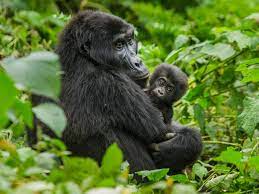Mountain Gorillas of Virunga
An exhilarating hike to see the mountain gorillas
Bwindi Impenetrable Forest National Park sits in the southwestern tip of Uganda, Africa, positioned on the border of the Democratic Republic of Congo next to Virunga National Park. Bwindi is sanctuary to many colobus monkeys and chimpanzees, but perhaps its most famous inhabitants are the 400 Bwindi gorillas, which make up roughly half of the population of all endangered mountain gorillas.
There are 14 gorilla groups one can visit in Bwindi, scattered across four unique forest sectors called Buhoma, Ruhija, Rushaga, and Nkuringo. As much as we wanted to visit them all, our time in Bwindi was limited to the Ruhija sector, where we had a “gorillas in the mist” experience that transcended the mist to the mystical.

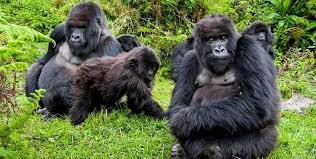
Most awareness of these splendid creatures comes from Gorillas of the Mist, the 1983 book by Dian Fossey, which was made into a film in 1988 starring Sigourney Weaver. Ms. Fosse’s research of the mountain gorillas from 1966 until her murder in 1985 laid a course to reverse the declining gorilla population in the Virunga Mountains. Today the Bwindi primates are protected by local rangers, who oversee guided treks into the Impenetrable Forest so we can see these animals up close and personal.
Laurin and I arrived in Bwindi near the end of a breathtaking twelve-day tour of Uganda booked through our local tour operator that has been there for many years. We checked in for two nights at the Bwindi Panorama Nature Resort. The resort is built at the summit of a hill with stilted cabins built into the hillside. From the deck of your cabin, you can sit and watch the sunset over the mountains… or enjoy the rolling mist in the valley below.
The next morning, we began the trek into Ruhija to meet the gorillas. A permit is required to enter the Impenetrable Forest, and only 16 permits are issued per day, so it’s good to acquire these permits in advance. Fortunately, our local tour operator will secure the necessary permits as part of your safari package.

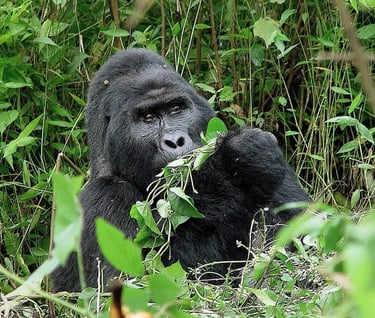
There are a few things to be aware of when entering the forest. First, if you have been sick with a viral infection that transmissible by air (i.e. the common cold), you will not be permitted to enter. Gorillas are susceptible to a handful of human viruses, and because there are so few gorillas left, this precaution is taken for their safety.
Second, there is no guarantee that you will actually see gorillas. Gorillas are nomadic in nature, and they like to move about the forest, so they rarely settle in one place for very long. Local rangers scout the forest throughout the night to locate gorilla groups, then relay this information to their guides the next morning. It is very rare that a tourist makes the trek without seeing a gorilla, but it does happen nonetheless. Also, there are times when a party of trekkers may hike all day, traveling deep into the forest before a gorilla group is found. As such, one should be in good shape and ready for what could become a full day’s workout.

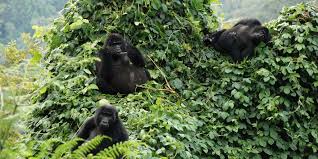
On the other hand, many trekking parties are quite fortunate. We were one such party. We had been hiking a mere 20 minutes when our guide stopped us, chattered something into his radio, then relayed the information back to us—we had found a gorilla family. To reach the family, our party would have to leave the beaten trail, climbing through an untrodden section of forest that descended down the mountain at roughly a 35-degree angle. Local porters were available for hire to assist hikers in this endeavor, and the route was through such a tight cluster of trees that there was plenty to hold onto during the descent.
Still, it was rough and treacherous going. We all moved gingerly in a serpentine pattern down the hill, testing each step for purchase. The fact that it had been raining earlier in the morning made this slope more interesting, and as we pressed on, we found ourselves dropping into a pocket of mist that had settled against the mountain.
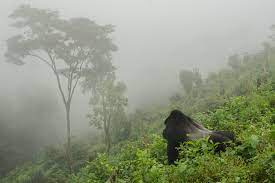

At last, the hill leveled out to a small plateau surrounded by trees. There we saw them—a small gorilla family, two females, three babies, and one massive silverback crouched at the edge of the clearing, staring into the forest. The guide had instructed us that we had one hour alone with these great primates, and those sixty minutes passed in what felt like six.
At one point, a baby gorilla no bigger than a housecat came wandering along in front of us, passing so close to my boot that it could have reached out and untied it. At another point, the silverback moved back into the clearing and prowled about assessing us for threats. I have video of Laurin taking photos, standing roughly ten yards away, and as I zoom in on the great alpha ape, he takes a few strides toward us, balancing on his massive forearms.
A blink, and then it was over.
The guides led us back up the steep hill to the main path. Once we were there, we were given another treat: a female gorilla could clearly be seen a few feet away, her baby clinging to her chest. She reached into the bushes and stripped long leaves from the branches for food. One of the guides approached her and used a hooked machete to pull down more branches for her, giving us all a better view of her in the process.
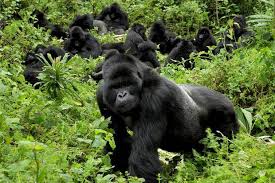

The mother did not flinch as he approached, so comfortable was she with the presence of humans. It is for this reason that the forests are constantly patrolled by rangers, as these gentle gorillas will allow poachers to walk right up to them.
The hike back out of the forest was like a dream. As we moved along the trail, a soft mist filtered in through the treetops. In the distance, we could see mist creeping up the side of the hill like a free solo climber, softening the afternoon from an approaching storm.
We took a lot of pictures. Even now we look at them, unable to believe it was real. An opportunity to visit the Bwindi gorillas in their own habitat is a once-in-a-lifetime experience.
